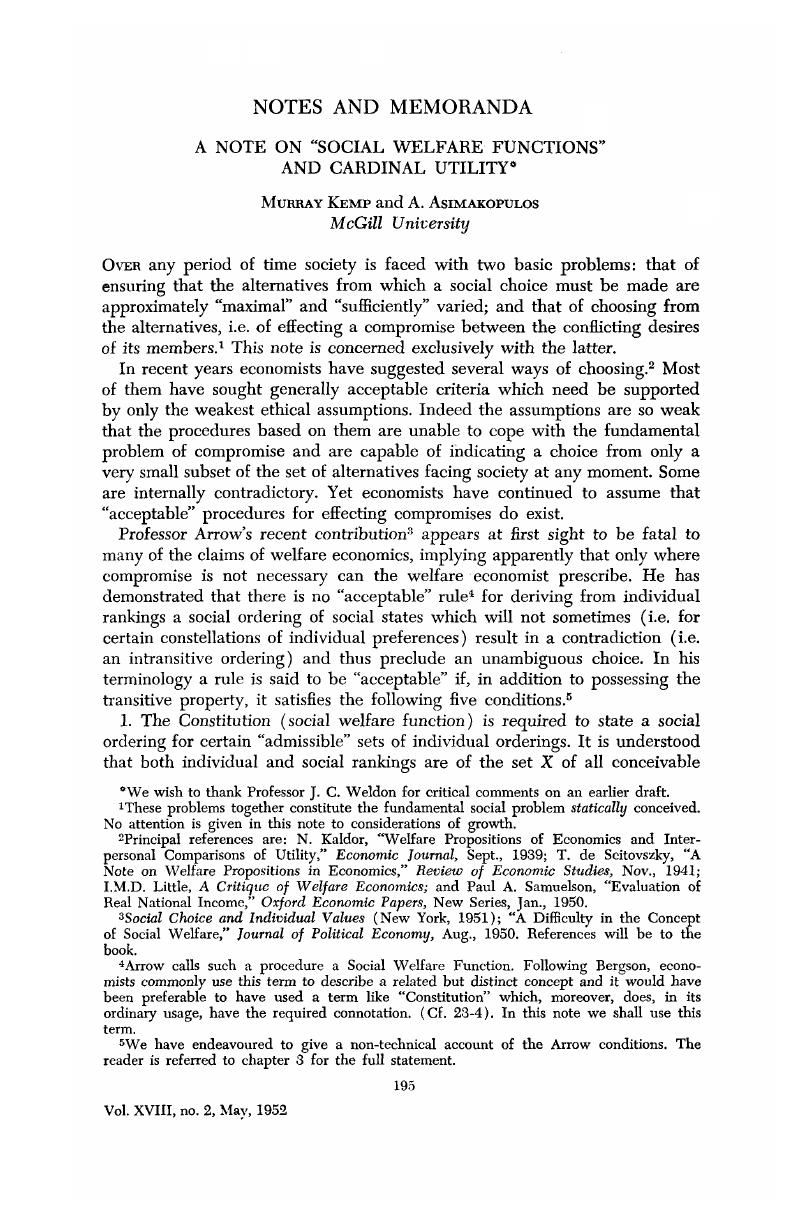Published online by Cambridge University Press: 07 November 2014

We wish to thank Professor J. C. Weldon for critical comments on an earlier draft.
1 These problems together constitute the fundamental social problem statically conceived. No attention is given in this note to considerations of growth.
2 Principal references are: Kaldor, N., “Welfare Propositions of Economics and Interpersonal Comparisons of Utility,” Economic Journal, 09, 1939 CrossRefGoogle Scholar; de Scitovszky, T., “A Note on Welfare Propositions in Economics,” Review of Economic Studies, 11, 1941 Google Scholar; I.M.D. Little, A Critique of Welfare Economics; and Samuelson, Paul A., “Evaluation of Real National Income,” Oxford Economic Papers, New Series, 01, 1950.Google Scholar
3 Social Choice and Individual Values (New York, 1951)Google Scholar; “A Difficulty in the Concept of Social Welfare,” Journal of Political Economy, 08, 1950.Google Scholar References will be to the book.
4 Arrow calls such a procedure a Social Welfare Function. Following Bergson, economists commonly use this term to describe a related but distinct concept and it would have been preferable to have used a term like “Constitution” which, moreover, does, in its ordinary usage, have the required connotation. (Cf. 23–4). In this note we shall use this term.
5 We have endeavoured to give a non-technical account of the Arrow conditions. The reader is referred to chapter 3 for the full statement.
6 The first three are explicitly stated (p. 6–8), the fourth seems to be implicit in the analysis.
7 The Theory of Games and Economic Behavior (2nd ed.), 15–30 Google Scholar and Appendix.
8 The meaningfulness of these statements is derived from the fundamental assumption about interpersonal utilities.
9 Arrow presents first the proof of the 2-individual, 3-alternative case. The key step is the derivation of consequence 3: If x′Pxy′ and y′P2x′, then x′ly′. This is based on the following assumption: x′P1y′ and y′P2x′ implies either always x′ly′ or always x′Py′ or always y′Px′. This is merely the spelling out of the condition that the social ordering depends only on individual orderings. The either … or is used in the exclusive sense. On this point Arrow is not entirely consistent: compare his definition (p. 13) and his usage in the statement of Lemma 1 (e) (p. 14). It will be found impossible to derive all of statements (2) - (6) (p. 50–1) if it is allowed, in our manner, that orderings are not all-important. Constitution 1 does not commit itself in advance to deciding whether x′P1y′ and y′P2x′ implies x′Py′ or x′ly′ or y′Px′. A one-to-one correspondence between two sets of individual orderings is neither necessary nor sufficient for the same social ordering.
Arrow next presents the proof of the many-individual, three-alternatives case. The key step is the derivation of consequence 4: If V′ is decisive for either x against y or y against z, V′ is decisive for x against z, where x, y, z are distinct alternatives (p. 54). Again, the proof is based on generalization from a special set of assumptions about individual orderings with the aid of the condition that only individual orderings are to count, (p. 55–6). Under Constitution 1 no one set of individuals can be always “decisive”. Indeed, there is no decisive set under Constitution 1. Whether or not a particular subset of voters can be “decisive” in any particular election depends on the preferences of other voters.